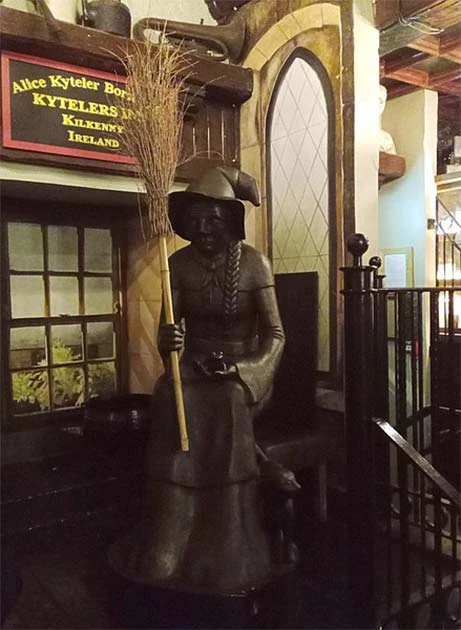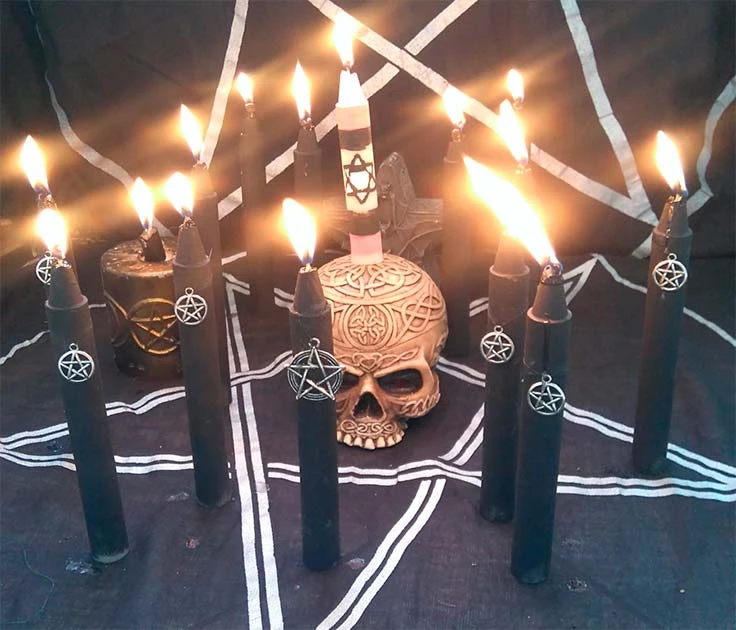Perhaps the most famous witch trials of all time were the Salem Witch Trials in America in the late 1600s. But the reality is there were thousands of trials and executions of witches that occurred across Europe and the New World.
The accusations of witchcraft, trials, and forced confessions extracted under torture led to the deaths of around 100,000 people in Europe during the early modern period from about 1400 to 1775. From France to England, to Rome, and Germany, healers, the mentally ill, hags, single women over the age of 40, and a small number of men were executed for heresy and witchcraft, and many were burned at the stake.
But before Europe saw most of its witch trials, Ireland was the first country to have written records about the accusation and trial of a witch in 1324. The first witch of Ireland was Alice Kyteler, a woman who became very wealthy and whose husbands had the unfortunate tendency to drop dead. Who was Alice Kyteler, and why was she said to be a witch?
Alice Kyteler
Dame Alice Kyteler became the first person in recorded history to be condemned for witchcraft in Ireland. She was born sometime in 1263 in County Kilkenny to her Flemish merchant parents, who migrated to Ireland in the mid to late 13th century.
Alice was married four times during her life, and she was accused of killing her husbands by her stepchildren after she claimed her widow’s dower and even the property of the husband. Had she not stepped in, the money and land would have been given to the stepchildren.
Alice Kyteler’s first husband was William Outlaw, whom she was married to from around 1280 to 1285 when he died. William was a rich merchant as well as a moneylender who was also from Kilkenny, just like Alice.

The pair had one known child, also named William Outlaw, and there is a possibility she had a daughter that might have been Rose, but no other information about her survives. William Jr was indeed the only child (according to records) that Alice Kyteler certainly had. She did not have kids with any of her future husbands.
William Jr and Alice took over William Sr’s moneylending business, and William Jr became the Mayor of Kilkenny in 1305. Because Alice lived so long ago, there is no information about the cause of death of Alice Kyteler’s first husband, but by 1285, he had passed away.
Alice Kyteler’s second husband was a man named Adam Blund, whom she married by 1302. Like her first husband, Adam was a very wealthy moneylender from Callan.
The couple did not have any children together, but Alice became the stepmother of Adam’s children from a previous marriage. We do not know what happened to Adam Blund other than that he died, and Alice was married once again by 1309.
- The Forfar Witches: On Trial for their Lives
- “Thou Shalt Not Suffer a Witch to Live”: The Witch-Cult Hypothesis
Husband number three was a man named Richard de Valle. Richard came from a distinguished family in County Tipperary and was a well-to-do landowner, who would die in turn in 1316. Shortly afteward, Alice Kyteler sued one of her stepsons, who was also named Richard, for her widow’s dower.
A widow’s dower was a provision set by the husband or his family to give money and property to the wife if she were to become widowed. Her action to claim her dower seemed suspicious to the stepchildren, but this may well have come from their expectations of an inheritance: if Alice Kyteler had not stepped in to get what she was legally owed by marriage, the money and property of Richard de Valle would have been given to his surviving children.
Alice married her fourth husband, John le Poer, the same year her third husband died. The pair were married from 1316 to 1324. Like her other husbands, Alice once again became a stepmother to her husband’s children from a previous marriage.

While Alice Kyteler and John le Poer were together, the Bishop of Ossory, Richard de Ledrede, attempted to arrest Alice on suspicions of murder and “other crimes”. John stepped in and defended his wife, and she was never taken into custody.
John did not believe what the other stepchildren were saying when they accused Alice Kyteler of murder. Well, that was until John became sick himself of what was described as a “wasting disease.” John suspected that he was being poisoned to death by his wife, but nothing was done until after he died in 1324.
The Original Wicked Stepmother?
After John le Poer died, all of Alice Kyteler’s stepchildren became very suspicious of how their fathers died, and they were angry that Alice had gotten all the money to which they felt entitled. The kids felt that Alice and her son William had supernatural abilities and had used them to trick and woo their fathers, kill them, and get their money.
At least, that is the claim. Those of a more cynical and suspicious disposition might speculate that the children, finding themselves disenfranchised by this late arrival of a new wife, had a powerful motive to slander Alice. Such behaviors are nothing new.
The children took their concerns to the Bishop of Ossory, who was more than happy to arrange an inquiry to put Alice Kyteler on trial at last. Witnesses were gathered from the local area, but again there were issues of bias as it is believed that many of those said witnesses were in debt to Alice and William. The stepchildren also testified against Alice.
Alice Kyteler and her son William Outlaw Jr were accused of being powerful sorcerers and heretics, along with ten other individuals who were labeled as their accomplices. She was on trial for witchcraft, also known then as Maleficarum, and causing the deaths of innocent Christians.
Alice and the “accomplices” were said to “concoct powders and potions made from all sorts of vile ingredients, which – mixed in the skull of a decapitated robber and surrounded by candles made of human fat, and accompanied with horrible incantations brought illness and death.”

If that wasn’t enough, it was alleged that “in order to make their spells and potions even more effective, all members renounced Christianity and, going further, to have sought the aid of demons, to whom they sacrificed animals.” Alice was accused of having her own personal demon, which was an incubus that she had sexual relations with.
It was through the incubus that Alice was able to become so wealthy. Her wealth, by the time of the trial, was described as “unheard of wealth” because for a non-royal woman to be rich and have a successful moneylending business was impossible without the help of demons.
Lurid stuff, and depressingly typical of such cases where religion becomes involved in testate law. Of course, there was no evidence, but the mere accusation was often enough.
- The Woodplumpton Witch: The Uneasy End of Britain’s Last Witch Trial
- The Book of Shadows: Is There a Secret Witches’ Spellbook?
The formal charges that Alice Kyteler was being tried for were:
- Seeking the advice of demons on witchcraft
- Holding coven meetings and burning candles in the church at night without permission. (also accused of this were an additional eight people.)
- Denying the power of Christ and the Church. (at this time in history, renouncing your faith was seen as someone choosing to worship Satan.)
- Making dark magic-based powders and ointments or potions from disturbing ingredients, including the limbs and organs of unbaptized children, to corrupt her husbands.
- Sacrificing animals to two demons known as Artis Filius and Robin Artisson.
- Having sexual relations with the incubus Robin Artisson. Artisson was said to turn into an animal or an Ethiopian when engaging in relations with Alice Kyteler.
- Casting spells upon and killing her husbands just so she and her biological son, William Outlaw, could be rich.
After the inquisition, Alice’s maid, Petronilla of Meath (some sources have “Petronella”), was flogged upon the bishop’s orders and confessed to six of the seven charges made at the inquiry. She was not only flogged; she was tortured into confessing, but given that the confession was a draft by Bishop of Ossory himself, what exactly was done to Petronilla is unknown.
Alice Kyteler and Basilia, the daughter of Petronilla, managed to escape before their sentences were handed to them. None of the other individuals on trial tried to flee, perhaps hoping in the face of all the evidence for a fair trial.

Alice however was warier than this. She disappeared to either England or Flanders, and there are no other records about Alice Kyteler, so we do not know how, where, or when she died.
After fleeing, the Bishop continued to persecute the rest of the accused individuals and charged them all with witchcraft. Petronilla was publicly flogged and then burned at the stake on November 3, 1324.
Were any of the accusations true? There were a lot of marriages and a lot of early deaths, and there is no doubt that Alice Kyteler became substantially richer through inheritance during her lifetime. It does all add up to something suspicious.
Alice Kyteler may indeed have poisoned one or more of her husbands, but there was never any firm evidence to prove it. As for the grinding up of unborn children and taking an incubus as a lover, I think we can safely say these were courtroom fictions. Murderer, maybe. Victim, certainly.
Top Image: Alice Kyteler outlived multiple husbands and became very wealthy in the process. Source: RuanDelpozo / CC BY-NC 3.0.